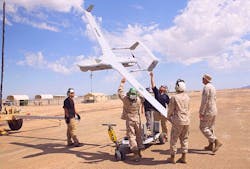Navy orders six RQ-21A UAV reconnaissance drones from Boeing Insitu in $70.1 million deal
Officials of the Naval Air Systems Command at Patuxent River Naval Air Station, Md., announced a $70.1 million order this week to Boeing Insitu Inc. in Bingen, Wash., for six full-rate-production lot-1 Blackjack unmanned aerial systems, which include air vehicles, ground control stations, multi-mission plug-and-play payloads, launch and recovery equipment, systems engineering, and program management.
The Navy announced a separate $71.6 million order to Boeing Insitu last June for six new RQ-21A Blackjack small tactical UAVs for the Navy and Marine Corps.
The Boeing Insitu RQ-21 is a twin-boom, single-engine, monoplane UAV for surveillance and reconnaissance. Users can launch and recover the reconnaissance drone on land or at sea without runways by using a pneumatic launcher and net-type recovery system.
Related: Army asks Textron to provide Shadow unmanned aircraft and tactical data link retrofits
The 81-pound Blackjack is eight feet long with a 16-foot wingspan, and is designed to carry multi-sensor payloads in a large pod below its nose. The UAV can fly as quickly as 104 miles per hour, cruises at 63 miles per hour, can fly as long as 24 hours, and can fly as high as 19,500 feet. It is a version of the Insitu Integrator UAV.
Users can customize the RQ-21A Blackjack's multi-mission open-architecture payload bays with visible-light and infrared cameras, communications, and other tools to provide situational awareness information to warfighters on the forward edge of battle.
The drone can integrate new payloads quickly, offers roll-on, roll-off capability to move the system quickly from ship to shore, as well as to and from cargo aircraft. The UAV can carry sensor payloads as heavy as 39 pounds.
The Blackjack's standard sensor payload consists of a visible-light imager, mid-wave infrared imager, laser rangefinder, infrared marker, communications, and automatic identification system.
Related: Pegaz Tactical Unmanned Aerial Vehicle (UAV)
The RQ-21A will provide persistent maritime and land-based tactical reconnaissance, surveillance, and target acquisition (RSTA) data collection and dissemination capabilities to sailors and Marines.
For the Marine Corps it will provide the expeditionary force, divisions, and regiments with a dedicated intelligence, surveillance, and reconnaissance (ISR) system that sends information to the tactical commander in real time.
For the Navy the Blackjack will provide persistent RSTA information to Navy ships, Marine Corps land forces, Navy expeditionary combat command forces, and Navy special warfare units.
On this order, Boeing Insitu will do the work in Bingen, Wash., and Hood River, Ore., and should be finished by February 2018. For more information contact Boeing Insitu online at www.insitu.com, or Naval Air Systems Command at www.navair.navy.mil.
Learn more: search the Aerospace & Defense Buyer's Guide for companies, new products, press releases, and videos
